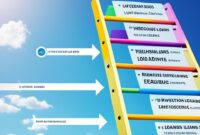Going to college can be costly, but government student loans help students pay for it. These loans come from the federal government and cover tuition, fees, room, board, textbooks, and more. With these loans, students can get the money they need to reach their education goals and start their careers.
Government student loans have many benefits for college funding. They have fixed interest rates, which means the cost stays the same over time. Also, these loans offer flexible repayment plans to fit your budget. If you work in certain fields or do public service, you might even get your loan forgiven.
To get government student loans, start by filling out the Free Application for Federal Student Aid (FAFSA). This form checks if you qualify for grants, work-study, and loans. By doing the FAFSA, you can see what loans you might get and use this help for your education.
Key Takeaways
- Government student loans provide financial aid to help students pay for college expenses
- These loans offer fixed interest rates and flexible repayment options
- Loan forgiveness may be available for certain professions or public service
- Completing the FAFSA is the first step to accessing government student loans
- Government student loans are a valuable resource for funding higher education
Understanding Government Student Loans
Government student loans help students pay for their education. They come from the federal government and have fixed interest rates, flexible repayment plans, and programs for loan forgiveness. It’s important for students to know about these loans and how to get them.
Types of Government Student Loans
There are two main types of government student loans: Federal Direct Loans and PLUS Loans:
- Federal Direct Loans, also known as Stafford Loans, are the most common. They can be subsidized or unsubsidized, based on the student’s need. Subsidized loans have the government paying the interest while the student is in school. Unsubsidized loans require the student to pay all the interest.
- PLUS Loans are for graduate students or parents of students. They have higher interest rates and limits than Federal Direct Loans and need a credit check to get approved.
“Federal student loans are a great way to invest in your future. They offer competitive interest rates and flexible repayment options, making it easier for students to access the education they need to succeed.” – Sarah Thompson, Financial Aid Advisor
Eligibility Requirements for Government Student Loans
To get government student loans, students must meet certain criteria:
- Show they need financial help (for subsidized Federal Direct Loans)
- Be enrolled at least half-time in a program that leads to a degree or certificate
- Keep up with academic progress
- Be a U.S. citizen, permanent resident, or eligible non-citizen
- Fill out the Free Application for Federal Student Aid (FAFSA)
The FAFSA is key to applying for government student loans. It asks for financial info about the student and their family. This info helps figure out how much financial aid the student might get. It’s important to fill out the FAFSA right and send it in on time to increase your chances of getting loans and other aid.
| Loan Type | Eligibility Criteria | Interest Rate (2023-2024) |
|---|---|---|
| Federal Direct Subsidized Loan | Undergraduate students with financial need | 4.99% |
| Federal Direct Unsubsidized Loan | Undergraduate and graduate students, regardless of financial need | 4.99% (undergraduate), 6.54% (graduate) |
| PLUS Loan | Graduate students or parents of dependent undergraduate students | 7.54% |
Applying for a Government Student Loan
Applying for a government student loan has several steps. These include filling out the FAFSA, sending in documents, and knowing how loans get approved. By doing these steps right, students can get the financial aid they need for school.
Completing the Free Application for Federal Student Aid (FAFSA)
The first step is to fill out the Free Application for Federal Student Aid (FAFSA). This form asks about the student’s and their family’s money situation. It helps figure out if the student can get different kinds of financial aid, like government loans. It’s important to give accurate and current info on the FAFSA for the best chance of getting aid. For more on applying for student loans, check the Federal Student Aid website or talk to the school’s financial aid office.
Submitting Required Documentation
After sending in the FAFSA, students get a Student Aid Report (SAR). This report goes to the colleges listed on the FAFSA. The financial aid offices use this info to check if the student can get a loan. Sometimes, students need to send more documents, like tax returns or proof of income, to prove what they said on the FAFSA.
It’s important to answer any requests for more info quickly to avoid delays in getting the loan approved.
Understanding the Loan Approval Process
After the financial aid office looks over the FAFSA and any extra documents, they send the student a financial aid award letter. This letter tells the student what aid they can get, like grants, scholarships, work-study, and loans. If they get a government student loan, they must sign a Master Promissory Note (MPN). This is a legal document that explains the loan’s terms, like interest rates and how to pay it back.
| Loan Approval Step | Description |
|---|---|
| FAFSA Submission | Students fill out and send the FAFSA online |
| Student Aid Report (SAR) | Students get the SAR, a summary of their FAFSA info |
| Financial Aid Award Letter | Schools send students an award letter showing what aid they can get |
| Master Promissory Note (MPN) | Students sign the MPN to agree to the loan’s terms and conditions |
Knowing how loans get approved and taking the right steps can help students navigate their school journey with more confidence and peace of mind.
Federal Direct Loans: Subsidized vs. Unsubsidized
Federal Direct Loans help students pay for school costs. They come in two types: subsidized and unsubsidized. Knowing the differences helps students choose the right financial aid.
Subsidized Federal Direct Loans
Subsidized Federal Direct Loans go to students who really need them. The government pays the interest while students are in school, during the grace period, and when they defer. This saves borrowers a lot of money over time.
Unsubsidized Federal Direct Loans
Unsubsidized Federal Direct Loans don’t depend on need. They’re for all students, no matter their family’s income. But, interest starts adding up right away. Students can pay the interest or let it grow and add to the loan balance.
Comparing Subsidized and Unsubsidized Loans
It’s important to look at subsidized and unsubsidized Federal Direct Loans closely. Think about interest, how much you can borrow, grace periods, and how you’ll pay back. Here’s a table that shows the main differences:
| Feature | Subsidized Loans | Unsubsidized Loans |
|---|---|---|
| Financial Need | Required | Not Required |
| Interest Accrual | Government pays interest while in school and during grace period | Student responsible for all interest |
| Loan Amounts | Lower limits based on financial need | Higher limits, not based on financial need |
| Grace Period | 6 months after graduation or dropping below half-time enrollment | 6 months after graduation or dropping below half-time enrollment |
| Repayment Terms | Multiple repayment plans available | Multiple repayment plans available |
Both types of Federal Direct Loans have fixed interest rates set by Congress each year. By understanding these differences, students can make better choices about their financial aid and school costs.
Pell Grants: Need-Based Financial Aid
Pell Grants are a type of financial aid for undergraduate students with high financial need. They are funded by the federal government and don’t need to be paid back. This makes them a great choice for students who need help paying for college.
To get a Pell Grant, students must fill out the Free Application for Federal Student Aid (FAFSA). The FAFSA looks at the student’s and their family’s income and assets. It then calculates the expected family contribution (EFC). Students with a low EFC are more likely to get Pell Grants because they show they really need the help.
The amount of Pell Grant money you can get depends on several things. These include your EFC, if you’re going to school full-time or part-time, and the cost of your college. For the 2021-2022 year, the most you can get is $6,495. But, you might get less based on your situation and how much you need.
“Pell Grants provide a valuable opportunity for students from low-income families to pursue higher education without the burden of extensive student loan debt.” – Sarah Thompson, Director of Financial Aid at the University of California, Los Angeles
To get a Pell Grant, students must fill out the FAFSA every year they’re in college. It’s easy to do online. After you send in your FAFSA, your college will check if you qualify for a Pell Grant and add it to your financial aid package.
Even with a Pell Grant, you might not cover all your college costs. You might need to look into other ways to pay, like scholarships, work-study programs, or government student loans. These can help fill the gap between your Pell Grant and what you owe for school.
Loan Limits and Interest Rates
Understanding government student loans means knowing about borrowing limits and interest rates. These limits set how much you can borrow each year and during your studies. Interest rates also play a big part in the loan’s cost. Let’s dive into these key points of government student loans.
Annual and Aggregate Loan Limits
Government student loans have limits on how much you can borrow each year and overall. These limits depend on your school year and if you’re considered dependent or independent. Dependent students, who get financial help from parents, borrow less than independent students. Here are the yearly borrowing limits for both:
- Dependent undergraduate students: $5,500 to $7,500 per year
- Independent undergraduate students: $9,500 to $12,500 per year
- Graduate and professional students: Up to $20,500 per year in Direct Unsubsidized Loans
There are also limits on how much you can borrow over time, known as aggregate limits. These limits prevent students from borrowing too much. They help keep the government student loan program sustainable.
Current Interest Rates for Government Student Loans
Interest rates for these loans don’t change and are set by Congress each year. They stay the same, making it easier for borrowers to plan their payments. Here are the rates for the 2021-2022 school year:
| Loan Type | Interest Rate |
|---|---|
| Undergraduate Direct Subsidized and Unsubsidized Loans | 3.73% |
| Graduate Direct Unsubsidized Loans | 5.28% |
| PLUS Loans (for graduate students and parents) | 6.28% |
Even though these rates seem low, they can still increase the loan’s cost over time. To reduce the impact of interest, consider paying back some while in school. Or look into income-driven repayment plans to keep your payments low.
Knowing about borrowing limits and interest rates is key when getting government student loans. By understanding these, you can make smart choices about financing your education. This helps you manage your debt better in the future.
Loan Disbursement and Use of Funds
After your government student loan is approved, you’ll learn how the loan funds will be given out and what they can pay for. The disbursement process makes sure the funds are used for school and that you get the financial help you need.

How Loan Funds are Disbursed
The process of giving out government student loan funds is straightforward. First, the money goes straight to your college or university. Then, it pays for tuition and fees. If you live on campus, it also covers room and board costs.
Any money left over is given to you to pay for other school costs. You might get a check, direct deposit, or a credit to your school account, based on your school’s rules.
Permitted Uses of Government Student Loan Funds
These loans are meant to help you pay for school costs. Besides tuition and fees, you can use them for:
- Room and board (for students living on campus)
- Textbooks and course materials
- Computers and software needed for classes
- Transportation to and from school
- Living expenses (for students living off-campus)
It’s important to use your loan money wisely and only for school. Misusing it can lead to big problems, like:
| Consequence | Description |
|---|---|
| Loss of eligibility for future financial aid | Students who misuse loan funds may be denied access to additional financial assistance in the future. |
| Immediate repayment of the loan | If the misuse of funds is discovered, the student may be required to repay the entire loan amount immediately. |
| Legal action | In severe cases, students may face legal consequences for misusing government student loan funds. |
To avoid these issues and use your loan right, make a budget and keep track of your spending. Knowing how your loan is given out and what you can use it for helps you manage your money better during your school years.
Repaying Your Government Student Loan
After you finish your education, knowing how to pay back your government student loans is key. You usually start paying back your loans six months after you graduate, leave school, or go to less than half-time. This grace period lets you get ready for the loan repayment.
Repayment Plans for Government Student Loans
The U.S. Department of Education has different repayment plans to help you manage your loans. The main plans are:
- Standard Repayment: This plan has fixed monthly payments for 10 years, helping you pay off your loans in a decade.
- Income-Driven Repayment: Plans like Income-Based Repayment (IBR) and Pay As You Earn (PAYE) set your payments based on your income and family size. This makes paying back easier.
- Extended Repayment: If you owe a lot, this plan lets you pay back over 25 years. You can choose fixed or graduated payments.
Loan Consolidation Options
If you have several federal student loans, consolidating them into one Direct Consolidation Loan might help. It makes paying back easier since you only have one monthly payment. Consolidation could also open up certain repayment plans or forgiveness programs for you.
Loan Forgiveness Programs
Loan forgiveness can erase part or all of your student loan debt. Two main programs are:
- Public Service Loan Forgiveness (PSLF): Working full-time for a government or non-profit can make you eligible for PSLF. After 120 qualifying payments, the remaining balance on your Direct Loans might be forgiven.
- Teacher Loan Forgiveness: Teachers in low-income schools who work full-time for five years can get up to $17,500 off their Direct Subsidized and Unsubsidized Loans.
For a look at different repayment plans and their monthly payments, see the table below:
| Repayment Plan | Monthly Payment | Repayment Term |
|---|---|---|
| Standard Repayment | Fixed | 10 years |
| Income-Driven Repayment | Based on income and family size | 20-25 years |
| Extended Repayment | Fixed or graduated | Up to 25 years |
Knowing about your repayment options, consolidation, and forgiveness programs helps you make a plan that fits your finances.
Benefits of Government Student Loans
Government student loans offer many benefits for students needing financial help for school. They have fixed interest rates, which don’t change over the loan’s life. This means borrowers know exactly how much they’ll pay back. Unlike private loans, whose rates can go up or down, government loans are steady and affordable.
Government student loans also have deferment options. If you’re struggling financially, going back to school, or in the military, you can pause or lower your payments. This helps borrowers keep up without missing payments or facing big problems.

Income-driven repayment is another big plus. It lets you pay based on your income and family size. This makes paying back the loan easier. Plus, if you work in certain public jobs or meet certain conditions, you might get your loan forgiven, reducing or wiping out what you owe.
“Government student loans have been a lifeline for me. The fixed interest rates and income-driven repayment options have made it possible for me to pursue my dreams without being overwhelmed by debt.”
– Sarah Johnson, Graduate Student
Many government student loans don’t check your credit. This means students with little or no credit can still get loans. It helps students from all financial backgrounds get into college. This way, government loans help make education more equal for everyone.
| Benefit | Description |
|---|---|
| Fixed Interest Rates | Interest rates remain constant throughout the life of the loan |
| Deferment Options | Ability to temporarily pause or reduce payments during financial hardship, school enrollment, or military service |
| Income-Driven Repayment | Monthly payments are adjusted based on the borrower’s income and family size |
| Loan Forgiveness | Certain public service jobs or meeting specific criteria can lead to loan forgiveness after a specified period |
| No Credit Check | Most government student loans do not require a credit check, making them accessible to students with limited credit history |
Alternatives to Government Student Loans
Government student loans are a common choice for many students. But, there are other ways to pay for college. Private student loans come from banks, credit unions, and other lenders. They can help or replace government loans. These loans have different rules, interest rates, and ways to pay back compared to federal loans.
Scholarships and grants don’t need to be paid back. They’re great for students wanting to reduce their debt. These can be based on grades, need, community work, sports, or other things. Students can find these through their college’s financial aid office, online, or community groups.
Work-study programs give students with financial need part-time jobs. This way, they can earn money for college costs. Employer tuition help is another choice. Companies offer money for employees who work for them for a while or keep a good grade point average. Looking into these options can help students make college more affordable.







